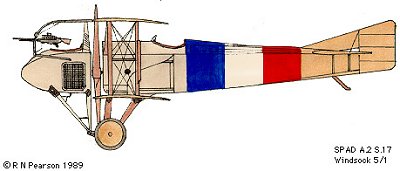The Societe Anonyme pour l'Aviation et ses Derives A.2 (SPAD A.2):
Historical Notes:
The forward nacelle did allow the gunner, with a flexible mount, to engage enemy aircraft freely in the frontal arc. However, communication between the gunner and pilot, separated by the engine as well as close to five feet of distance, would degrade the effectiveness of the machine. The installation of a communications tube which passed through the hub of the propeller was the attempt to solve this problem, but rarely worked as efficiently as the textbooks would like one to believe. Essentially, the pilot maneuvered the aircraft while the gunner attempted to engage targets. The A.2 was powered by a 110hp Le Rhone rotary 9J engine, which had cooling troubles due to the obstruction of the forward nacelle.
Only about one hundred A.2s were built, with 57 of them going to Russia to serve in the Imperial Air Service. The front position was one in which few men dared to man, largely because of the obvious risks of such a location. If a takeoff or landing accident were to occur, the gunner would certainly be crushed by the engine behind him, while the propeller presented serious risk of injury or death. A wire screen was placed behind the gunner's head to protect him, but this was not always sufficient, and there were incidents of gunners being killed when such items as a scarf would fly back and catch in the blades, or when enemy fire would damage the nacelle mount, causing the entire structure to fall from the aircraft. Moreover, the front position was extremely cold, having no engine heat coming back into the compartment. Suggestions were made to replace the manned gunner's position with four fixed machine guns, and this actually was done on the SG version, which was only designed as a prototype. Several Russian aviation crews claimed victories in the Spad A.2 and its sister, the A.4.
While seeing very limited front line service, the Spad A.2 and its sister types became the basis for more successful Spad designs of the future, and in this regard this machine was truly a pioneer aircraft. Some sources will also list the A.2 as the Spad II.
Basic performance statistics: SPAD A.2
Engine: 110hp Le Rhone Rotary 9J (some used in Russian service had the 80hp rotary)
Weight: empty 935 lbs; loaded: 1,562 lbs
Maximum speed: 87 mph at sea level
Climb rate: to 6,562 feet (2,000 m).... 12 min, 30 sec.
Service ceiling: 13,100 feet
Flight endurance: 3 hours
Basic Specifications:
Manufacturer: Societe Anonyme pour l'Aviation et ses Derives (SPAD)
Dimensions: Span 31 ft 4 in; Length 23 ft, 11 in; Height: 8 ft, 6.5 in
Areas: Wings 273 sq ft
Fuel: na from sources
Armament: single Lewis machinegun with flexible mount in gunner's nacelle; 4-5 drums carried (about 388 to 485 rounds typical load).
Primary sources: "French Aircraft of the First World War," Davilla and Soltan; "Jane's Fighting Aircraft of World War I, 1919 (1990 reprint); "British Aeroplanes, 1914-1918," J.M. Bruce; "German Aircraft of the First World War," Gray and Thetford; "Military Small Arms of the 20thCentury," Hogg and Weeks.
Fighting and winning in the SPAD A.2:
